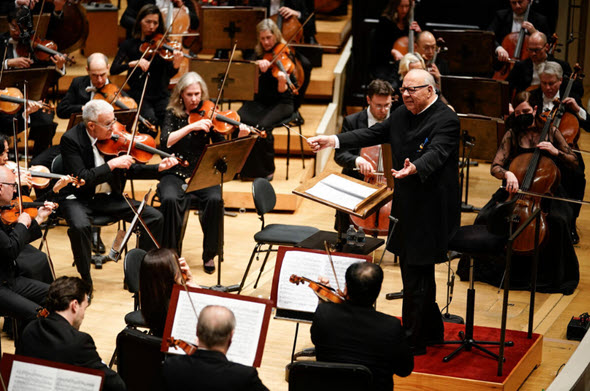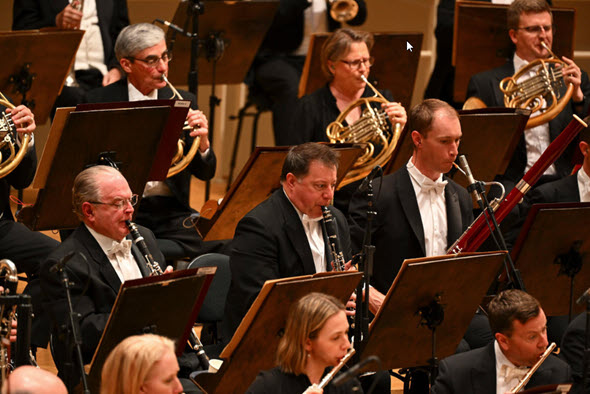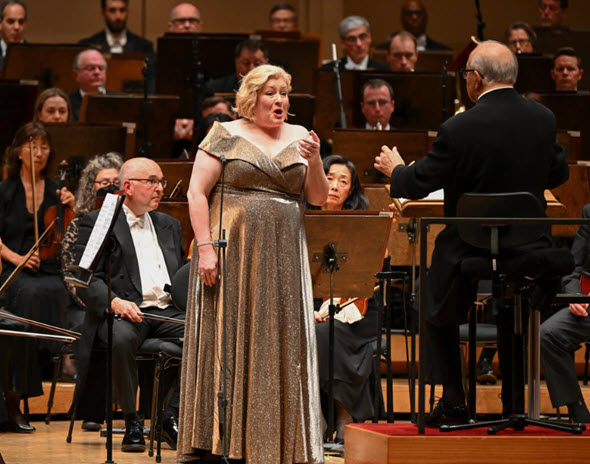Neeme Järvi, elder statesman on the podium, leads CSO in Mahler 2nd of intimate grandeur

Neeme Järvi conducted the Chicago Symphony Orchestra and Chorus in Mahler’s Second Symphony. (Todd Rosenberg photos)
Review: Chicago Symphony Orchestra and Chorus conducted by Neeme Järvi at Orchestra Hall.
By Lawrence B. Johnson
It’s surely unusual to begin a concert review with a statement of full disclosure. But I feel duty-bound to note that I go back a long way with the Estonian conductor Neeme Järvi, who led the Chicago Symphony Orchestra in a transcendent performance of Mahler’s Second Symphony at Orchestra Hall on the memorable evening of May 23. I found this latest encounter singularly touching and as thrilling as that packed house obviously did.
Järvi was music director of the Detroit Symphony Orchestra from 1990 to 2005, during all of which time I was the music and theater critic for The Detroit News. He was always Neeme. I think if I’d ever addressed him as Maestro, he would have blinked and laughed. Järvi is a marvelously humane and skilled conductor with a great sense of humor. He’s 87 years old now, which means he was in his mid-sixties the last time our paths crossed in Detroit two decades ago. But he still conducts with his hips and shoulders as well as his hands.
And there’s still some ham in him, as the thong at Orchestra Hall saw in the midst of a stormy ovation for his Mahler: Järvi turned and gestured toward the orchestra as if to pass the noisy acknowledgement on to the musicians; it got louder, but he apparently didn’t think it was loud enough, so he cupped his hands behind his ears until he heard the roar he wanted.
Physically, the years have slowed Järvi a bit. He moved haltingly from the wings to the podium, where a chair awaited him. But from the start, the conductor was out of that chair as much as he was in it. Intellectually, musically, Järvi displayed all the acuity and imagination, the grace and precision I recall from those many seasons in Detroit. This was a detailed, commanding account of Mahler’s vast symphony, a grand canvas for large orchestra and chorus with solo soprano and mezzo-soprano. The work’s five movements, an 80-minute sprawl, tries the endurance and concentration of everyone on stage. And the huge finale, Mahler’s dramatically fraught but spiritually profound consummation, becomes the ultimate test.
Mahler regarded each of his symphonies as a world unto itself, each a portrait of human existence with all of its delights and trials. Someone asked me after this performance why Mahler’s symphonies have become so crazily popular — why they are played two, three times every season by every orchestra. Perhaps we see our careening world, our precarious lives in them. Symphony No. 2 in C minor (“Resurrection”) is just such an existential tapestry, and the CSO’s performance with Järvi captured its panoply of human imagery: joy, anxiety, optimism, pain and, as countless billions have shared with Mahler, a vision of transmigration.
What unfolded was as striking for its finesse and transparency as for its raw power. The opening ripped, double basses slashing the air, the full orchestra in collective proclamation of the hour of reckoning come. And yet almost immediately, Järvi guided the sound to its antithesis: sweetness and light. The specter of death had met the prospect of hope. The contest was on.
The work’s second and third movements, the former a rustic pastoral episode replete with dance and sunlight and the latter a quicksilver scherzo that bends toward uncertainty, form the essence of earthly life. Järvi’s take on both was brisk, impulsive, exuberant and irresistible. Then came the turning point, the fourth movement, when all this clattering worldliness is settled onto a solitary figure at a spiritual crossroads in a song titled “Urlicht” (Primal Light). Mezzo-soprano Karen Cargill’s magnificent, softly voiced delivery all but rendered visible a soul in transition who, finding her way back to God impeded, vows that no one, nothing will prevent her return to the Maker whence she came.
And so begins the grand ascent of Mahler’s finale, which bears no small resemblance to the choral conclusion to Beethoven’s Ninth Symphony. Here the message isn’t brotherhood but faith that “nach kurze Ruh” (after a short rest), the flesh become dust will rise again. The CSO Chorus first invoked that assurance in a mere whisper: “Aufersteh’n, ja aufersteh’n wirst du, mein Staub…” (Rise again, yes, you will rise again my dust), then ultimately unleashed the same text in a heaven-storming affirmation that brings the symphony to its close.
The sheer force Järvi summoned, the precise dynamic arc shaped by the chorus, the CSO’s eloquently inflected playing all produced a hair-raising last movement. The augmented orchestra, including 11 French horns with four of them periodically moving offstage to create the ethereal summons of judgment, served as a reminder of how delicately and pointedly Mahler could employ the forces he required. Much like Beethoven’s Missa Solemnis or Bach’s Mass in B minor or the Verdi Requiem, the message here manifestly transcends any religious boundaries. It is about something tremendous within human grasp, within the heart, to which anyone and everyone can aspire.
The torrential outpouring of thanks from the packed house offered compelling testimony to the potency of art, the Chicago Symphony’s artistic splendor and the perdurable mastery of an interpretive artist whose spark belies, or perhaps bespeaks, his 87 years.






Järvi is a musical master and interpreter, “maestro” is an apt and well-deserved title whether he likes it or not! We attended the May 22nd dress rehearsal of this Mahler Resurrection symphony by the CSO. It was a fully engaging experience. Observing the conductor’s insights into the music through dialogue with the musicians was enlightening and at times, entertaining. Jarvi’s approach was clear as evidenced by his constructive comments, suggestions and sometimes firm, but gentle, demands.
From this review it seems the moments that he focused on during rehearsal achieved his goals with players and singers alike. His command of the music, his concept of this daunting musical score was secure and supremely confident. The communication between conductor and orchestra was a joy to behold. Järvi communicated his directions and corrections, politely, confidently and often with humor clearly convincing orchestra members to play it his way.
The orchestra, chorus and soloists rose to the occasion, even though it was ‘just’ a rehearsal. It was a wholly enjoyable afternoon demonstrating how the “sausage gets made!” We are fortunate to have such an accomplished, seasoned orchestra, chorus and soloists. The opportunity to experience Järvi work his magic with them in rehearsal was amazing.
I’ll take a mature, confident, experienced orchestral conductor any time!